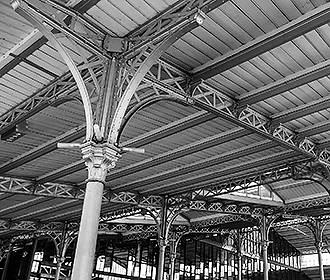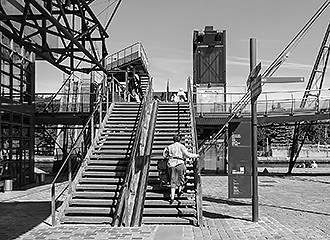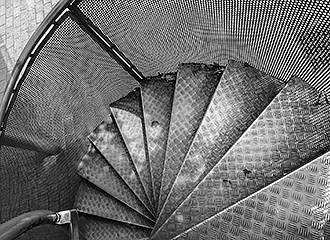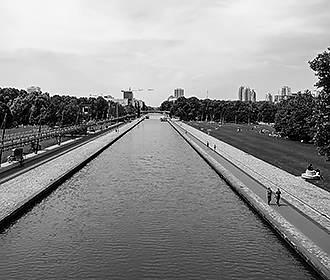Paris Parc de la Villette History
The Paris Parc de la Villette is one of the largest Paris parks that now has the largest science museum in Europe, theatres and music halls and much more to discover, yet started out as an abattoir, or slaughterhouse for cattle.
Parc de la Villette history the 1800s
The large expanse of the Paris Parc de la Villette is located on the outskirts of Paris in the 19th Arrondissement and upon the orders of Napoleon III and the prefect Baron Haussmann, it was transformed into a cattle market with beef slaughterhouses as the city wanted to concentrate the abattoirs in one area.
The now historical Grande Halle aux Boeufs, or Great Hall of Cattle was the main former cattle hall of the Abettoirs de la Villette and covering an area of 20,000 metres squared, this was constructed between the years 1865 and 1867 by the architect Jules Merindol and at its height used to handle up to 4,500 heads of cattle per day.
And built around an area that encompassed the Canal de l’Ourcq, which was originally built on the orders of Napoleon I to provide Paris with water, there were originally three different cattle market halls and the area of La Villette got the nickname of La Cite du Sang, or The City of Blood by butchers.
But the March of 1974 marked the end of an era when the last of the Villette slaughterhouses closed, but it was not until 1979 that Paris Parc de la Villette history re-started with a grand project to renew and redevelop the whole area, yet the Grande Halle itself was saved from destruction due to its architectural value and was also put on to the supplementary inventory of historical Paris monuments.
Paris Parc de la Villette history the transformation
Now the main tasks outlined for developing this 55 hectare area was to create an urban cultural park that would be open to everyone, along with a place devoted to music and another devoted to science and technology, but it has become far more.
The architectural design for this Paris park started in 1982 with an international competition that brought together over 400 teams from over 40 different countries and it was Bernard Tschumi, who was a French architect of Swiss origin, that finally came out the winner in the March of 1983.
The whole Paris Parc de la Villette history and projects was done in stages and of course the area was designed with different gardens, but it was the construction of different buildings that made the major difference and were some of the first things to be officially opened.
One of the first major developments was the construction of the Zenith at the edge of the Canal de l’Ourcq, which is a concert arena that can accommodate over 6,000 people and this makes it one of the largest venues in Paris.
Now this project in Parc de la Villette was designed by the architects Philippe Chaix and Jean-Paul Morel and was first inaugurated in the January of 1984, and has seen many great names in pop music perform here such as Celine Dion, Cyndi Lauper, Bob Dylon and Oasis.
The next stage in Paris Parc de la Villette history was the renovation of the Grande Halle de la Villette, which was entrusted to Bernard Reichen and Philippe Robert and is a venue for fairs and exhibitions, etc and was inaugurated in the January of 1985.
The very same year in the May of 1985, the Geode, which is a completely unique building that is a movie theatre and has the largest hemispherical screens in the world, was inaugurated. And equivalent to a 12 story building, this amphitheatre boasts the title of the best attended cinema in France, and its unique design has become famous throughout the world.
The next stage of the development of the Parc de la Villette history, was the construction of the Cite des Sciences et de l’Industrie, which is the largest science museum in Europe, and was first officially opened in the March of 1986 by Francois Mitterand on the occasion of the Giotto space probe with Halley’s Comet.
And then the October of 1987 saw the inauguration of the first themed gardens within the Parc de la Villette Park with its water features, fountains, ornamental ponds, walkways and vast green spaces along with childrens playgrounds.
But the next major phase in the development of the Parc de la Villette history was the new cultural area that was not completed until the December of 1990, with the inauguration of the prestigious Conservatoire National Superieur de Musique et de Danse de Paris.
And by 1991 the decommissioned submarine called the Argonaute was also in its final resting place and unveiled to the public as another one of the unusual Paris museums that you could discover.
However, the Paris Parc de la Villette history does not stop there, as there were even more projects planned for this large area and designed by the French architect Christian de Portzamparc, in the January of 1995 the Cite de la Musique and the concert halls first opened their doors. But you may also like to know that the Salle Pleyel close to the Champs Elysees is a concert hall that is home to the Paris orchestra, and this is a subsidiary of the Cite de la Musique.
Paris Parc de la Villette history was then followed two years later, by the opening of the music museum, called the Musee de la Musique, which now has one of the richest collections of instruments in the world and you can even get to hear some of these impressive musical instruments being played, just as was their original purpose.
Yet even to day there are plans for new cultural spaces and the Theatre Paris-Villette is being refurbished and will be open again in 2014. So even though this particular Park park is not right in the heart of the city, there is so much to do here with family or friends, that it makes it a great venue for a fun day out in the city.



